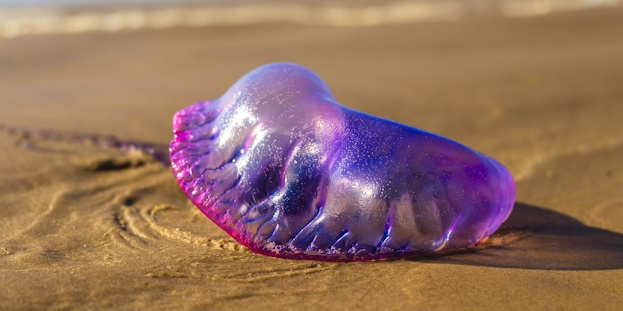Types, Regions & Dangers for Tourists 2025
The Croatian Adriatic coast is known for its clear, turquoise waters and beautiful beaches. But many tourists wonder: Are there jellyfish in Croatia? And are they dangerous?
Short answer: Yes, there are jellyfish in Croatia – but most species are harmless. Only a few can cause discomfort for swimmers. In this article, you will learn which jellyfish species are found in Croatia, where they appear, the risks involved, and how to handle them safely.
Our Tip
Hotels in Croatia are best booked via Booking.com . The platform offers a wide range of accommodations – from cozy guesthouses to luxury resorts – and genuine guest reviews to help you find the perfect stay. Flexible booking options, often free cancellation, and attractive prices make planning your trip simple and safe.
Are Jellyfish Common in Croatia?
Jellyfish are naturally present in the Adriatic Sea, but not everywhere and not in large numbers all year round. Their presence depends on currents, water temperature, and food availability.
- In spring and summer, jellyfish can appear more frequently, especially after storms or unusually warm periods.
- Their numbers fluctuate from year to year – some years see many jellyfish, other years almost none.
Jellyfish Species in Croatia
1. Moon Jellyfish (Aurelia aurita)
- The most common jellyfish in the Mediterranean.
- Almost transparent, with four white rings inside (the reproductive organs).
- Harmless to humans – stings are unpleasant but not dangerous.
2. Compass Jellyfish (Chrysaora hysoscella)
- Recognizable by the brown stripes on its bell.
- Tentacles can sting painfully.
- Risk: skin irritation, similar to a nettle sting.
3. Mauve Stinger (Pelagia noctiluca)
- One of the few jellyfish in Croatia that can cause real pain.
- Pink to violet, small but venomous stinging cells.
- Found more often in open waters, sometimes in bays.
- Risk: painful skin injuries, similar to a strong sunburn.
4. Barrel Jellyfish (Rhizostoma pulmo)
- Very large jellyfish, can reach 50–80 cm in size.
- Whitish-blue with thick tentacles.
- Impressive to see, but harmless to humans.
5. Portuguese Man O’ War (Physalia physalis)
- Technically not a jellyfish, but a siphonophore.
- Rare in the Adriatic, but occasionally seen, mainly in southern Dalmatia (e.g., south of Split, Dubrovnik region).
- Very dangerous – contact can cause severe pain and circulatory problems. Sometimes life-threatening.

Regional Differences in Croatia
Jellyfish distribution is not the same everywhere in Croatia.
- Istria (Pula, Rovinj, Umag):
Jellyfish are rare here. Cooler waters and strong currents usually push them further out to sea. - Kvarner Bay (Krk, Cres, Rab, Lošinj):
Sometimes more jellyfish, especially in summer. The bay shape encourages accumulation. - Dalmatia (Zadar, Split, Dubrovnik, Hvar, Korčula):
Mauve Stingers often seen, especially after storms. In sheltered bays, numbers can temporarily increase. - Open sea & islands:
Chances of seeing jellyfish are higher further offshore. Bays with heavy boat traffic usually have fewer.
Are Jellyfish Dangerous in Croatia?
- Most species are harmless and only cause minor skin irritation.
- The Mauve Stinger can cause painful stings.
- Rarely, the Portuguese Man O’ War can be life-threatening.
First Aid for Jellyfish Stings
If you are stung while swimming in Croatia:
- Stay calm and swim to shore.
- Remove tentacle remnants carefully with tweezers or a seashell (do not use bare hands).
- Rinse with seawater (not freshwater, which can activate stinging cells).
- Vinegar or saltwater may help neutralize venom (use caution with Mauve Stinger, cool gently instead).
- Do not rub – this worsens the skin reaction.
- If severe reactions occur (difficulty breathing, circulatory problems, intense pain, allergic reactions), call 112 immediately.
Tips for Tourists
- Check local information: Many beaches post signs or have apps with up-to-date jellyfish info.
- Observe swimming bans: If the red flag is up, do not enter the water.
- Educate children: Do not touch jellyfish even on the beach – tentacles remain toxic for a long time.
- Bring a small first aid kit: A tube of cortisone cream or antihistamine can be useful.
Conclusion – Jellyfish Are Rarely a Problem in Croatia
The likelihood of being stung by a dangerous jellyfish in Croatia is quite low. Most species are harmless; only the Mauve Stinger may cause discomfort. With some caution and knowledge of first aid, a carefree swimming holiday in Croatia is entirely possible. The Portuguese Man O’ War is rare but very dangerous.